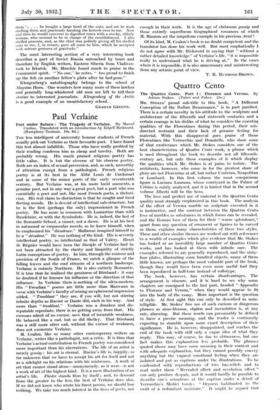Quattro Cento
Mn. SroxEs' proud sub-title to this book, " A Different Conception of the Italian Renaissance," is in part justified. There is a certain novelty in his attitude to the sculpture and architecture of the fifteenth and sixteenth centuries and a certain courage in his dislike of what he considers the essential qualities of the Florentines during this period, their mis- directed restraint and their lack of genuine feeling for material. With this disapproval goes praise of those Florentines like Verrocchio and Donatello, who show some of that exuberance which Mr. Stokes considers one of the best characteristics of Quattro Cento work, a phrase which is used throughout the book to describe not all fifteenth- century art, but only those examples of it which display the qualities which Mr. Stokes is at pains to isolate. The architects, however, who come in for the greatest share of glory are not Florentine at all, but rather Umbrian, Neapolitan or Lombard. In this first volume the most conspicuous figure is Luciano Laurana, whose courtyard in the Palace of Urbino is subtly analysed, and it is hinted that in the second volume Alberti will be the hero.
The love and perfect use of material is the Quattro Cento quality most strongly emphasized in this book. The analysis of the effect of Verona marble on sculpture executed in it is instructive, and the contrast between the Quattro Cento love of marbles as substances in which forms can be revealed, and the Roman love of them for their " warm splendours,', apart from any question of ornament or figures to be carved in them, explains many characteristics of these two styles. These and other similar themes are worked out with references to a wealth of examples which give evidence that Mr. Stokes has looked at an incredibly large number of Quattro Cento works, and has looked at them with infinite care. The examples referred to are generally reproduced, and the sixty- four plates, illustrating some hundred objects, many of them little known, are perhaps the most valuable part of the book, though they would have been even more useful had they been reproduced in half-tone instead of collotype.
The book, however, has certain disadvantages. The arrangement is obscure, and it is hard to see why some chapters are consigned to the last part, headed " Appendix to Florence and Verona," when they would appear to fit into the body of the essays More important is the question of style. At first sight this can only be described as unin- telligible. Mr. Stokes' free use of such curious or dangerous phrases as stone-blossom, rhythm and incrustation is, at any rate, alarming. But these words can presumably be defined to have a precise meaning, and the reader is continually expecting to stumble upon some exact description of their significance. He is, however, disappointed, and reaches the end of the book with still only a vague idea of what they imply. This may, of course, be due to obtuseness, but one fact makes this explanation less probable. The phrases quoted above may have some meaning in their context and with adequate explanation, but they cannot possibly convey anything but the vaguest emotional feeling when they are isolated and put as captions under the illustrations. To be confronted with reproductions of two bas-reliefs and to read under them " Revealed effect and revelation effect " can only produce despair, and it would hardly be possible to describe one's sensations at the caption under a detail of Verrocehio's Medici tomb : " Dryness habituated to the swirl of a redundant moisture." It might be argued that the illustrations are not meant to be studied without the text, but as a matter of fact they often will be. It looks as though the author believed that these phrases had a value out of their context, and, if this is so, it casts considerable doubt on his realization of their need of explanation in context.
ANTHONY BLUNT.































 Previous page
Previous page